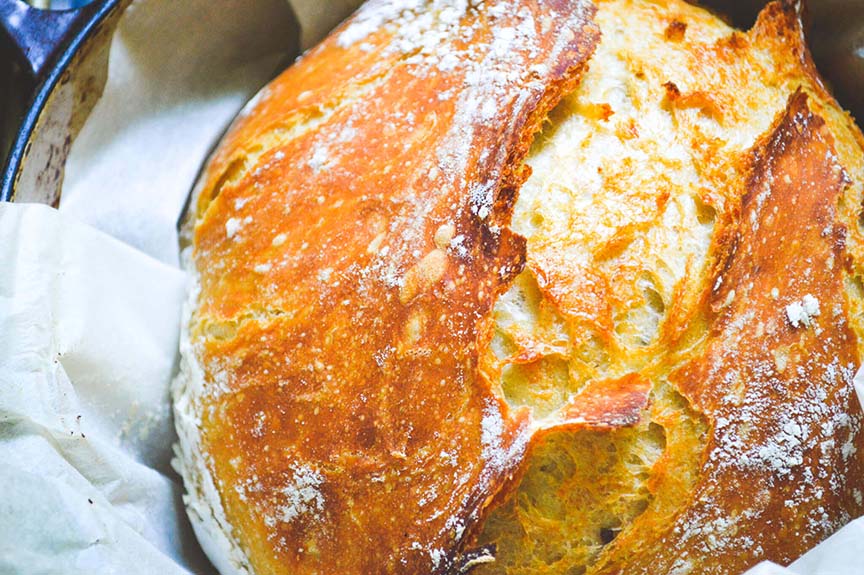There is a reason they call it “Your bread and butter.” Bread is an intrinsic part, not just of Scottish life, but of life around the world. Humans have been making bread in different permutations for over 10,000 years and whilst it may be a far cry from the Warburtons loaf we know and love (other brands are available) the flour, yeast, water, salt combination has been doing the rounds since day 1.
In 2019, a lot of people are turning their back on bread. Gluten intolerance, low carb diets, masochism; there’s lots of reasons why people are ditching dough in favour of lettuce wraps and mushroom baps.
Growing up in Scotland, my knowledge of bread extended to the medium white slice, brown if you were trying to be healthy and a tiger bloomer if you were entertaining. Sometime around the spawn of Gillian McKeith, seeded loaves suddenly start creeping into the bread bin with the promise of boosting zinc levels and waving a magic wand over our bowels.
Bread making was never a skill I ever considered to be useful or impressive. Like the majority of Britain, my parents bought into the Morphy Richard automatic bread maker. I think it was used 5 times, producing slabs of milky anvils, before spending a decade as a permanent installation at the back of the awkward corner cupboard.
The problem was that the bread maker was sold on convenience. The rosy image of spooning flour and yeast into a magic machine and waking up to the sweet homely smell of freshly baked bread; We can all be Nigella! Nothing, I repeat, nothing is as convenient as a £1 toastie loaf, delivered with your messages. Bread making is about care and attention. I personally believe that there is no greater expression of love than labouring in the kitchen. When you make bread for your home or for friends, it is about your investment of time.
The other problem with the bread maker is that we never learned the basics. The manual told us the weights of ingredients to put in. It beeped when it was done kneading and beeped when it was finished baking. It was all flash and no substance. We didn’t know why it didn’t work when it didn’t work and when we put it back in the cupboard we had no transferrable skills to develop.
So here it is readers; A crash course in bread making. Basic pillars that I hope will inspire you to take an inaugural step or triumphant return into the dough world. Give yourself, this day, your daily bread and remember that all bakers have dud days. Bread is an art and I’ve had many an Ecce Homo.
Yeast – Like bad taste, yeast is all around us. It is a fungus that creates gas as it consumes sugar. It is this gas that gives your dough rise. There are two main types of yeast in the UK for us hobby bakers; Active Yeast and instant yeast. Both are dry varieties that lie dormant until hydrated. Active yeast needs to be “bloomed” in warm water before use, whereas instant yeast can be mixed straight in with dry ingredients before hydration. Just remember; Active must be activated.
Sugar – Yeast needs sugar to produce carbon dioxide and alcohol; vital ingredients for fermentation and, in turn, bread making.
Salt – It’s a tightrope. Not enough salt and your bread will lack structure. Too much salt or the salt added at the wrong time with the wrong yeast and you’ll kill the rise.
Flour – There are umpteen varieties of flour and I would get lost in breaking them down. The most important thing I can tell you is that cheap plain flour is great for practising most beginner loaves. Strong high flour is great if you want lots of structure in your bread. Wholemeal flour needs more hydration to help it rise. Currently, I use Scotland The Bread wholemeal flour and Mungoswell strong bread flour.
Enriched Dough – Brioche, doughnuts, cinnamon buns, monkey bread; that sweet rich taste comes from an enriched dough. Enriched dough basically means that it has a higher fat content, most likely from milk, eggs or butter.
Plain or Pan – The old “Jeely Piece” song brought together the comparison of plain or pan. Basically, plain bread is batch bread, meaning loaves are cooked together, leaving the crust on the top and the bottom. Pan bread is bread made in a bread tin.
No-Knead, cast Iron Cob – You need a cast iron pot for this; Le Creuset, Staub, charity shops. No-knead bread has a low yeast content and a very wet dough that allows for a long fermentation. This long fermentation gives you long gluten strands; AKA big random air holes in your bread that will make it look rustic AF. The cast iron is heated before you place the dough in, which when combined with the wet dough, provides your bread with that tasty crust. We’ve got a recipe from Girl vs Dough on the blog.
Sourdough – Sourdough uses another variety of yeast called “Starter.” This Starter begins its life as flour and water. By allowing it to take in the bacteria from the air, it begins to ferment. This fermentation creates live yeast that can be used in your bread, providing the light sour taste.
Focaccia – A yeasted dough, cooked in a rimmed baking sheet with exorbitant amounts of olive oil. Focaccia relies on strong bread flour and gentle finger presses after proofing to create a structured, crispy, light texture.
Flatbreads – Pita, Naan Bread, tortillas; Flatbreads come in both leavened and unleavened varieties. Normally a more pliable dough that can be rolled out and grilled or shallow fried.
Prove (also called proof) – Proving is the process of resting the dough, allowing the mixture to ferment. This fermentation improves taste and develops the structure of the dough. Some doughs can prove overnight by reducing its temperature in the fridge. Leave your dough too long and you will over-prove. An over-proved dough will have a dense texture and look puffy.
Punch-down – There are a few reasons a recipe will tell you to punch-down a dough after its first rise. It removes large pockets of air and gives your finished bread a finer and more even crumb texture. This is great for sweet bread and sandwich bread. As the name suggests, you use your fist to push the risen dough back into the bowl. Google it if you can’t visualise.
Shape – Pretty much the last thing you do before putting your bread in the oven is giving it its shape. Baguette, pan, fougasse, cottage, Coburg. I am not a brilliant shaper. I really think this is one of those aspects of bread making that takes 10,000 hours of practice to perfect.
Kneading – I think we’ve all seen enough kneading in our lives to have an idea about what we need to do. The biggest lesson I’ve learned is that when a dough seems too wet, it just needs to be kneaded. Also, I never knead for long enough. Kneading incorporates air and starts to develop gluten which will allow your dough to rise properly. Don’t try to knead on a chopping board. You want a lightly floured surface. It’s messy. Deal with it.
Leavened – When you leaven a dough, you introduce air, which in turn helps it to rise. In bread making, there are really only two ways you’ll encounter leaveners. Yeast, we’ve covered; consumes sugar, creates gas. The other is chemical agents; baking powder and baking soda. Baking soda needs an acid to react with, creating a reaction that produces Co2. A great way to remember it is Soda = Sour. Acidic ingredients like buttermilk, yoghurt and lemon juice will make baking soda react. Baking powder has baking soda and an acidic powder already mixed in, which reacts when you introduce moisture. Powder has the Power.
As a home cook, this list covers the terminology I’ve found most useful a couple of years into my bread-making journey. If there’s any more that you think I should include, please drop me a DM on my Instagram @TenementKitchen. If you’re inspired to roll up your sleeves and whap out the yeast, please tag me in your creations. It will make my day! Happy baking!



1 Comment
by RonaldExeda
Устанавливать настоящие ресурсы во Титул игорный дом имеют все шансы только лишь юзеры, какие вступили во вид либо зафиксировали новейший. В Отсутствии авторизации нереально перечислять депозиты в результат также со него. Посетителям предполагается приступить со бездепозитного бонуса игорный дом, с целью коего в том числе и никак не потребуется дополнять равновесие.
Гранд казино
Comments are closed.